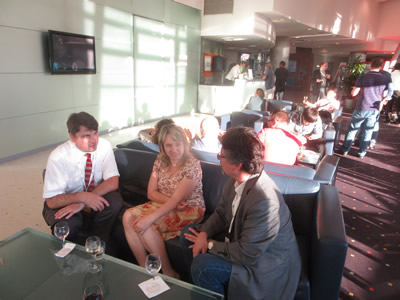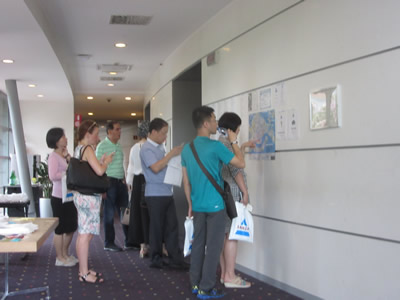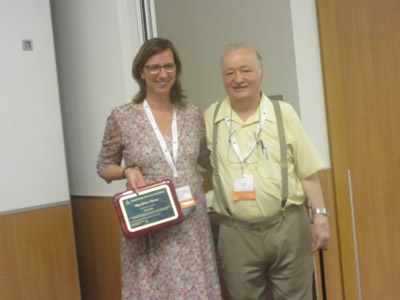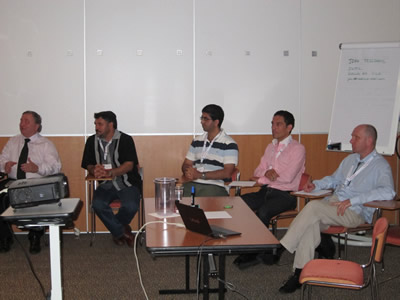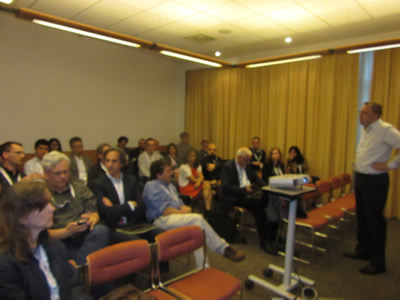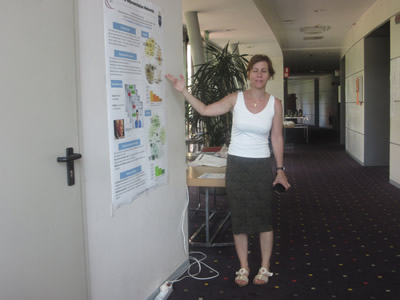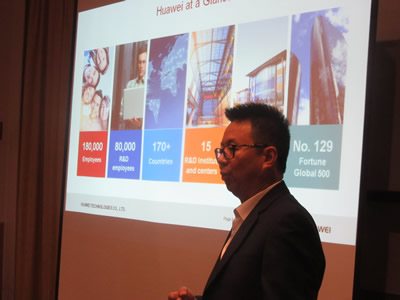CENTRIC 2024 - The Seventeenth International Conference on Advances in Human-oriented and Personalized Mechanisms, Technologies, and Services
September 29, 2024 - October 03, 2024
CENTRIC 2024: Call for Papers
Onsite and Online Options: In order to accommodate a large number of situations, we are offering the option for either physical presence or virtual participation (pdf slides or pre-recorded videos).
The evolution of services and the diversity of the user profiles composed with various contents and context-based access led to the development of specific mechanisms, services, and applications with a definitive, personalized, and user-centric flavor. Mechanisms are in place for service discovery using user profiles, for adapting the traffic following the quality of experience, or allowing personalized navigation and visualization. More is needed for network control and feedback consideration as well as for personalized storage and information retrieval within a given context.
There is a cohort of technologies that favored the so called “user-centric” services and applications. While some of them reached some maturity, others are to prove their economics (WiMax, IPTV, RFID, etc). The human-oriented and personalized technologies and services rely on a key set of features, some to be deployed, others getting more mature (personal profiles, preferences, identity, proximity, personal devices, etc.). Following, advanced applications covering human related activities benefit from personalized and human-oriented networks and services, especially preventive and personalized medicine, body networks and devices, or anticipative systems.
CENTRIC 2024 continues the series of events focusing on human-oriented and personalized mechanisms, technologies, and services, commonly known as I-centric. The conference will provide a forum where researchers shall be able to present recent research results and new research problems and directions related to them. The conference seeks contributions presenting novel result and future research in all aspects of user-centric mechanisms, technologies, and services.
We solicit both academic, research, and industrial contributions. We welcome technical papers presenting research and practical results, position papers addressing the pros and cons of specific proposals, such as those being discussed in the standard fora or in industry consortia, survey papers addressing the key problems and solutions on any of the above topics short papers on work in progress, and panel proposals.
Industrial presentations are not subject to the format and content constraints of regular submissions. We expect short and long presentations that express industrial position and status.
Tutorials on specific related topics and panels on challenging areas are encouraged.
The topics suggested by the conference can be discussed in term of concepts, state of the art, research, standards, implementations, running experiments, applications, and industrial case studies. Authors are invited to submit complete unpublished papers, which are not under review in any other conference or journal in the following, but not limited to, topic areas.
All topics and submission formats are open to both research and industry contributions.
CENTRIC 2024 conference tracks:
Building user-centric systems
User-centered research methods; User-centered methods for development and maintenance; Risks of user-centered design; Innovation and user-centered design; User-centered design in smart environments; Research on user competencies and requirements; Innovative user Interfaces (e.g., brain-computer interfaces); New types of human-computer-interactions (e.g., gestures)
Centric views
User centricity: I-centric versus We-centric; User-centric in service-centric systems; User-centric business models; User-centric requirements in network-centric approaches; User-centric and critical time-centric applications and services; User information access behavior; User-centric professional attackers; User-centric data mining; User-centric data aggregation; Personalized seeking and personalized sharing; Contextual user information facets; User-oriented ontology; User empowerment: awareness and control; User-centric trust models
User Centricity and Artificial Intelligence
AI-Support and Human Decision Making; Human Interpretable and Explainable AI; Data Annotation and Data Labeling Problems; Detecting and Dealing with AI Bias; User Acceptance of AI-Based Decision Making; AI for User Behavior Classification and Prediction; AI and Recommender Systems for Personalized Offerings
User Centered Design of Chatbots and Voice Assistants
User Requirements and User Acceptance; New Design Patterns and Approaches; Innovative Tools for Prototyping and Dialog Design; Wizard-of-Oz Testing and New Approaches for User Testings; Impact of Advances in Natural Language Detection; Methods for Analyzing and Classifying User Intents; Accessibility and Findability in Conversational Commerce
Affective computing and emotional intelligence
Frameworks for affective computing; Principles in emotional intelligence; Concepts in affective robotics; Social aspects of affective computing; Ambient systems embedding emotional intelligence; Empathy in artificial agents; Human-centric obedience towards virtual agents; Affective gaming; Deep multitask learning; Apps for body perceptions and emotions; Multi-sensing and human behavior; Active sensing system for distress detection; Recognition of facial emotions; Automatic prediction of depression and anxiety; Mitigate public speaking anxiety; Prediction of emotion from heartbeat; Conveying emotional awareness; Emotional intelligence; Happiness entailment; Cooperative machine learning; Emotion prediction; Emotion recognition; Emotion in ambiguous speech
Privacy and anonymity
Anonymity and pseudonymity; Attacks against de-identified data; Data anonymity; Consent-based privacy disclosure; Private digital assets; Disclosure control techniques; Information loss assessment; Risk assessment for shared information; Privacy and anonymity ontology; Privacy technologies; User location anonymity techniques; Privacy preserving data and text mining; Privacy and anonymity in specialized applications /healthcare. databases, information retrieval, social networks, etc./; Legal aspects in privacy and anonymity
User-centric supporting mechanisms
Machine learning and artificial neural networks; Network control and feedback with man-in-the-loop; Multi-sensor user interfaces (e.g., tactile, haptic, olfactory); Personalized storage and information retrieval with user-context; Service discovery using user profile; Personalized navigation and visualization; Semantic web services; Advanced personalization techniques for semantic wikis; Application of advanced reasoning maintenance; Reasoning on user modeling and personalization; Information extraction and semantic web technologies with personalization and user modeling; Quality of experience
Personalization
Personalization of ICT services and devices; Personalization of eHealth services; Personalization related to ICT in cars; Adaptive personalization; Supporting the user in initial set-up of user profiles; Personalization and user profile management; Preferences for personalization in manufacturers' devices; Standardization
User-centric networking and services
Personal profiles, preferences; Identity; Reputation; User profiles; Proximity and context-aware services; Social communities; User adapted services; Trust, privacy, security; Community services; Location services; Web 2.0 and Web 3.0; Key exchange, certificate handling, smartcards; Personal devices; Managing identity and security - identity provider; Home content access and rights management
User-centric advanced applications
Humanoids; Unmanned systems; On-body antennas; Body networks and devices; Preventive and personalized medicine; Anticipative systems for diagnosis and maintenance; Emergency and medical response systems; eHealth and telemedicine services; Personal entertainment
Technologies for personalized services
Personnel tracking; Presence automatic control; Remote home security control; User-centric recommender services; Identity management; Contactless radio: RFID, NFC; Proximity radio: Bluetooth, WLAN; Broadband and wireless broadband distribution; Ambient wireless and broadband networks; Social engineering and social networks; IPTV and Quadruple Play
People-centric sensing
People-centric sensing techniques, technologies, and applications; Participatory sensing; Smart phone sensing; urban sensing; Bio-medical sensing; Mixed sensor networks and people-centric sensing; SensorWeb; Mobility; Mobile social networks and sensing; Mobile healthcare and sensing; Platforms and architectures; Context awareness; Situation awareness and management
User experience and usability
Attributes and measurement; Ergonomics/human factors; User-Centered and contextual design; Design guidance/best practices; Usability heuristics, testing and evaluation; User feedback and response; Design tools and process; Prototyping technologies; Responsive design strategies; Innovative user interfaces
User research and usage behavior
Up-front user research; Use cases and case study research; Usage/user studies on new services; Adoption and diffusion research; Usage/demand forecasting and planning; Technology acceptance research; User behavior and attitudes; Social and cultural influences
Deadlines:
Submission | Jul 01, 2024 |
Notification | Aug 05, 2024 |
Registration | Aug 19, 2024 |
Camera ready | Aug 29, 2024 |
Deadlines differ for special tracks. Please consult the conference home page for special tracks Call for Papers (if any).
INSTRUCTION FOR THE AUTHORS
Authors of selected papers will be invited to submit extended versions to one of the IARIA Journals.
Publisher: XPS (Xpert Publishing Services)
Archived: ThinkMindTM Digital Library (free access)
Prints available at Curran Associates, Inc.
How to submit to appropriate indexes.
Only .pdf or .doc files will be accepted for paper submission. All received submissions will be acknowledged via an automated system.
Contribution types
- regular papers [in the proceedings, digital library]
- short papers (work in progress) [in the proceedings, digital library]
- ideas: two pages [in the proceedings, digital library]
- extended abstracts: two pages [in the proceedings, digital library]
- posters: two pages [in the proceedings, digital library]
- posters: slide only [slide-deck posted on www.iaria.org]
- presentations: slide only [slide-deck posted on www.iaria.org]
- demos: two pages [posted on www.iaria.org]
FORMATS
Only .pdf or .doc files will be accepted for paper submission. All received submissions will be acknowledged via an automated system.
Final author manuscripts will be 8.5" x 11", not exceeding 6 pages; max 4 extra pages allowed at additional cost.
Helpful information for paper formatting for MS Word can be found here.
There is a community provided LaTeX template: the CTAN package iaria (with full IARIA formatting rules, including IARIA citation style, but for providing citation style it is tightly bound to pdflatex+biblatex+biber). In addition, there is also iaria-lite (not bound to pdflatex+biblatex+biber, but compatible with any TeX stack; thus, it cannot provide the IARIA citation formattings, but only the titlepage and content-related IARIA formatting rules). Based on the iaria package, there is a minimal working example as Overleaf template. When you are using the LaTeX templates, please still adhere to the additional editorial rules.
Slides-based contributions can use the corporate/university format and style.
Your paper should also comply with the additional editorial rules.
Once you receive the notification of contribution acceptance, you will be provided by the publisher an online author kit with all the steps an author needs to follow to submit the final version. The author kits URL will be included in the letter of acceptance.
We would recommend that you should not use too many extra pages, even if you can afford the extra fees. No more than 2 contributions per event are recommended, as each contribution must be separately registered and paid for. At least one author of each accepted paper must register to ensure that the paper will be included in the conference proceedings and in the digital library, or posted on the www.iaria.org (for slide-based contributions).
CONTRIBUTION TYPE
Regular Papers (up to 6-10 page article -6 pages covered the by regular registration; max 4 extra pages allowed at additional cost- ) (oral presentation)
These contributions could be academic or industrial research, survey, white, implementation-oriented, architecture-oriented, white papers, etc. They will be included in the proceedings, posted in the free-access ThinkMind digital library and sent for indexing. Please submit the contributions following the instructions for the regular submissions using the "Submit a Paper" button and selecting the appropriate contribution type. 12-14 presentation slides are suggested.
Short papers (work in progress) (up to 4 pages long) (oral presentation)
Work-in-progress contributions are welcome. These contributions represent partial achievements of longer-term projects. They could be academic or industrial research, survey, white, implementation-oriented, architecture-oriented, white papers, etc. Please submit the contributions following the instructions for the regular submissions using the "Submit a Paper" button and selecting the contribution type as work in progress. Contributors must follow the conference deadlines, describing early research and novel skeleton ideas in the areas of the conference topics. The work will be published in the conference proceedings, posted in the free-access ThinkMind digital library and sent for indexing. For more details, see the Work in Progress explanation page. 12-14 presentation slides are suggested.
Ideas contributions (2 pages long) (oral presentation)
This category is dedicated to new ideas in their very early stage. Idea contributions are expression of yet to be developed approaches, with pros/cons, not yet consolidated. Ideas contributions are intended for a debate and audience feedback. Please submit the contributions following the instructions for the regular submissions using the "Submit a Paper" button and selecting the contribution type as Idea. Contributors must follow the conference deadlines, describing early research and novel skeleton ideas in the areas of the conference topics. The work will be published in the conference proceedings, posted in the free-access ThinkMind digital library and sent for indexing. For more details, see the Ideas explanation page. 12-14 presentation slides are suggested.
Extended abstracts (2 pages long) (oral presentation)
Extended abstracts summarize a long potential publication with noticeable results. It is intended for sharing yet to be written, or further on intended for a journal publication. Please submit the contributions following the instructions for the regular submissions using the "Submit a Paper" button and selecting the contribution type as Extended abstract. Contributors must follow the conference deadlines, describing early research and novel skeleton ideas in the areas of the conference topics. The work will be published in the conference proceedings, posted in the free-access ThinkMind digital library and sent for indexing. 12-14 presentation slides are suggested.
Posters (paper-based, two pages long) (oral presentation)
Posters are intended for ongoing research projects, concrete realizations, or industrial applications/projects presentations. The poster may be presented during sessions reserved for posters, or mixed with presentation of articles of similar topic. A two-page paper summarizes a presentation intended to be a POSTER. This allows an author to summarize a series of results and expose them via a big number of figures, graphics and tables. Please submit the contributions following the instructions for the regular submissions using the "Submit a Paper" button and selecting the contribution type as Poster Two Pages. Contributors must follow the conference deadlines, describing early research and novel skeleton ideas in the areas of the conference topics. The work will be published in the conference proceedings, posted in the free-access ThinkMind digital library and sent for indexing. 8-10 presentation slides are suggested. Also a big Poster is suitable, used for live discussions with the attendees, in addition to the oral presentation.
Posters (slide-based, only) (oral presentation)
Posters are intended for ongoing research projects, concrete realizations, or industrial applications/projects presentations. The poster may be presented during sessions reserved for posters, or mixed with presentation of articles of similar topic. The slides must have comprehensive comments. This type of contribution only requires a 8-10 slide-deck. Please submit the contributions following the instructions for the regular submissions using the "Submit a Paper" button and selecting the contribution type as Poster (slide-only). The slide-deck will be posted, post-event, on www.iaria.org.
8-10 presentation slides are suggested. Also a big Poster is suitable, used for live discussions with the attendees, additionally to the oral presentation.
Presentations (slide-based, only) (oral presentation)
These contributions represent technical marketing/industrial/business/positioning presentations. This type of contribution only requires a 12-14 slide-deck. Please submit the contributions following the submission instructions by using the "Submit a Paper" button and selecting the contribution type as Presentation (slide-only). The slide-deck will be posted, post-event, on www.iaria.org.
12-14 presentation slides are suggested.
Demos (two pages) [posted on www.iaria.org]
Demos represent special contributions where a tool, an implementation of an application, or a freshly implemented system is presented in its alfa/beta version. It might also be intended for thsoe new application to gather the attendee opinion. A two-page summary for a demo is intended to be. It would be scheduled in special time spots, to ensure a maximum attendance from the participants. Please submit the contributions following the submission instructions by using the "Submit a Paper" button and selecting the contribution type as Demos. The Demos paper will be posted, post-event, on www.iaria.org.
Tutorial proposals
Tutorials provide overviews of current high interest topics. Proposals should be for 2-3 hour long. Proposals must contain the title, the summary of the content, and the biography of the presenter(s). The tutorial slide decks will be posted on the IARIA site.
Please send your proposals to tutorial proposal
Panel proposals
The organizers encourage scientists and industry leaders to organize dedicated panels dealing with controversial and challenging topics and paradigms. Panel moderators are asked to identify their guests and manage that their appropriate talk supports timely reach our deadlines. Moderators must specifically submit an official proposal, indicating their background, panelist names, their affiliation, the topic of the panel, as well as short biographies. The panel slide deck will be posted on the IARIA site.
Please send your proposals to panel proposal



